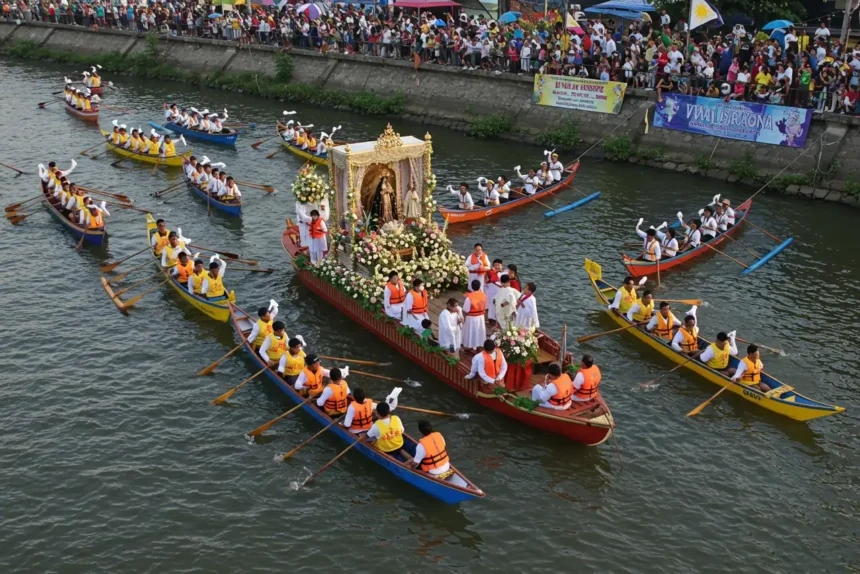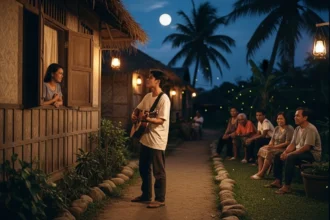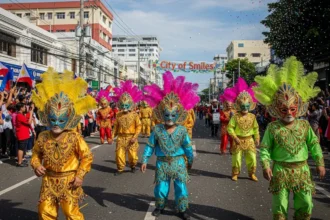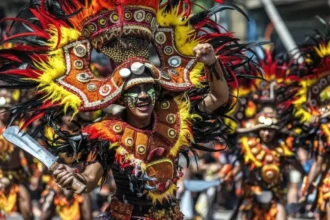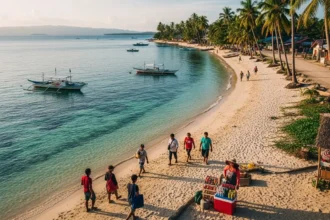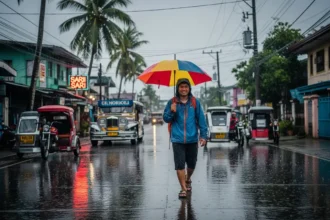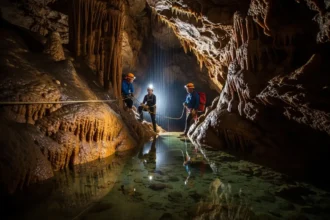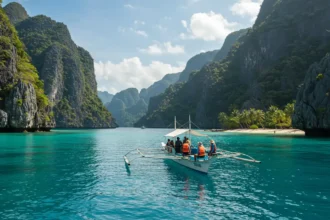Every September, the city of Naga in Bicol transforms into a sea of candles, flowers, and faith as millions gather for the Peñafrancia Festival – a grand celebration in honor of Our Lady of Peñafrancia, lovingly called Ina by her devotees.
For nine days, processions, prayers, and songs fill the air. Streets overflow with barefoot pilgrims, and the sound of rosaries blends with the rhythm of the river – where the fluvial procession carries Ina’s image back to her shrine, surrounded by glowing boats and thousands of faithful voices.
The Peñafrancia Festival 2026 isn’t just a religious event – it’s a moving expression of Filipino faith and resilience, where devotion and tradition come alive in every candle lit and every “Viva la Virgen!” shouted in the crowd.
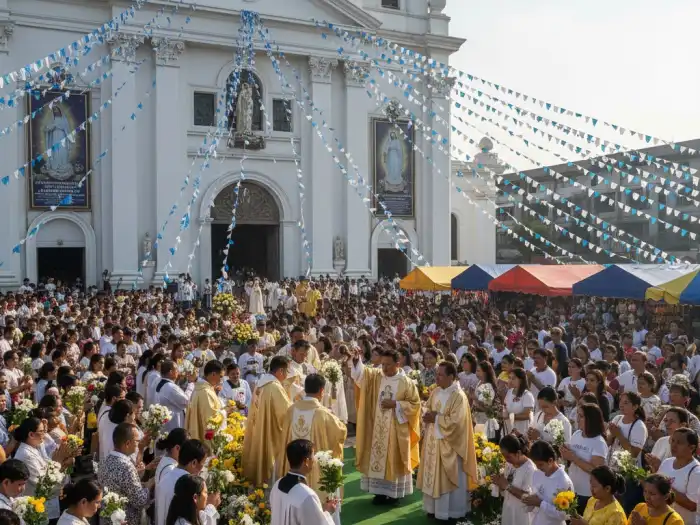
📅 2026 Schedule & Key Events
The Peñafrancia Festival 2026 will take place from September 11 to 22, 2026, in Naga City, Camarines Sur. It’s the biggest Marian celebration in Asia, honoring Our Lady of Peñafrancia, affectionately called Ina by millions of devotees.
The festival is built around the Traslacion (transfer of the image) and the Fluvial Procession, two sacred events that draw pilgrims from across the country and abroad. Whether you come for devotion, heritage, or sheer awe – these dates are worth marking on your calendar.
Here’s a full look at the 2026 Peñafrancia Festival schedule:
| Date (2026) | Event / Activity | What Happens |
|---|---|---|
| Sept 11 (Friday) | Traslacion Procession 🙏 | The image of Our Lady of Peñafrancia is transferred from her Basilica Minore to the Naga Metropolitan Cathedral. Thousands of barefoot male devotees carry the “andas” (carriage) in a solemn yet emotional walk. |
| Sept 12–20 (Sat–Sun) | Nine-Day Novena Masses ⛪ | Novenas are held daily at the Naga Metropolitan Cathedral. Each day features prayers, candle lighting, and Marian songs dedicated to Ina. |
| Sept 19 (Saturday) | Cultural Parade & Voyadores Festival 🎭 | A street celebration showcasing Bicol’s rich culture, costumes, and dances. The Voyadores represent the men who row the boats during the fluvial procession. |
| Sept 21 (Sunday) | Pontifical Mass & Fluvial Procession ⛵ | The highlight of the festival – the image of Ina is brought from the cathedral back to her basilica via the Naga River, accompanied by hundreds of candle-lit boats and prayers from the crowd. |
| Sept 22 (Monday) | Thanksgiving Mass & Closing Ceremony 🌅 | Final Mass at the Basilica Minore followed by community feasts and reflections. Locals call it the Pagsungko ni Ina – Ina’s return home. |
🌸 Local Devotion – The Traslacion
The Traslacion marks the festival’s emotional start. As the image of Ina leaves her basilica, thousands of men pull the ropes of her andas, many barefoot and weeping – a sight that moves even the most casual onlooker. It’s not a parade; it’s a pilgrimage.
Many devotees make personal vows (panata) to join every year – carrying candles, walking the full route, or staying awake all night to pray. It’s faith, raw and real, written on every face in the crowd.
🌊 The Fluvial Procession – Faith on the Water
The Fluvial Procession is the grand culmination of Peñafrancia. Ina’s image is placed on a pagoda adorned with flowers and candles, sailing slowly down the Naga River surrounded by hundreds of boats.
As the boats move, devotees chant “Viva la Virgen!” while thousands of candles flicker on the riverbanks – a glowing river of faith that feels almost otherworldly.
Devotee’s Note – Arrive Early for the Best View
The fluvial starts around 4:00 PM, but locals gather by noon along the Naga Riverbanks (Peñafrancia Avenue and Colgante Bridge) to secure a good spot. Bring a hat, water, and tissues – it’s deeply moving and emotional.
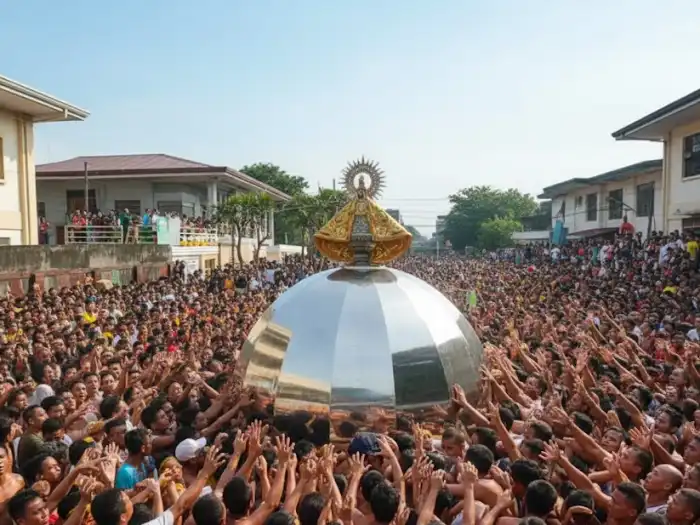
🎭 Festival Highlights & Cultural Traditions
The Peñafrancia Festival is not just a celebration – it’s a sacred homecoming. Every September, Naga City transforms into a place where devotion meets artistry, where faith finds its rhythm in processions, parades, and prayers.
Here’s what makes it truly unforgettable.
🙏 The Devotion to “Ina” – Mother of All Bicolanos
At the heart of the festival is Our Lady of Peñafrancia, fondly called Ina, which means “mother.” For Bicolanos, she isn’t just a religious figure – she’s family. Her image, gentle yet powerful, is believed to protect and bless devotees who call upon her.
The devotion began in the 1700s, when a Spanish seminarian named Miguel Robles de Covarrubias attributed his healing to Our Lady’s intercession. Out of gratitude, he built a small chapel – the humble seed that grew into today’s grand basilica and centuries of devotion.
Every year, devotees – from overseas workers to fishermen – return home to “be with Ina.” Many carry candles or family photos, whispering prayers for health, healing, or homecomings.
Faith Insight – Ina’s Presence is Felt, Not Just Seen
Locals say that during Peñafrancia week, the whole of Naga slows down. Even businesses close early. People speak softer, smile more, and take time to help pilgrims. It’s not just faith – it’s Ina’s grace moving through the city.
🚣 The Voyadores Festival – Strength and Brotherhood
The Voyadores Festival celebrates the men known as voyadores – from the Spanish “to row” – who guide the pagoda carrying Ina’s image during the Fluvial Procession.
Dressed in red and yellow, voyadores symbolize courage, humility, and unity. Their street dance reenacts the movement of the boats – dancers sway like waves, drums mimic the rhythm of rowing, and banners flutter like river winds.
Cultural Gem – Dance Like a Voyador
Visitors can join local workshops or try simple “voyador” steps during street parades. It’s a fun and respectful way to connect with the devotion – just remember to shout “Viva la Virgen!” with heart.
🎶 Music, Faith, and the City’s Pulse
Throughout the festival, Naga becomes a city of sounds. Church bells ring at dawn, brass bands march through streets, and choirs sing Marian hymns that echo through the cathedral walls.
Even non-Catholics find themselves swaying to the rhythm – because here, music isn’t just heard, it’s felt. The songs tell stories of miracles, family, and hope that unite generations.
Local Hack – Catch the Candlelight Rosary Procession
Held before the fluvial, this quiet, luminous event paints the streets in golden light. Pilgrims walk barefoot, holding candles and singing “Ave Maria.” It’s one of the most moving sights of the entire celebration.
🕊️ The People and the Pilgrimage
Thousands walk from nearby provinces – Albay, Sorsogon, and Camarines Norte – to Naga as part of their yearly penitensya or thanksgiving. Locals open their homes to strangers, offering water, food, or rest – small acts that reflect Ina’s love through her people.
By festival’s end, it’s not unusual to see teary-eyed pilgrims embracing each other at the basilica, whispering, “Salamat, Ina.”
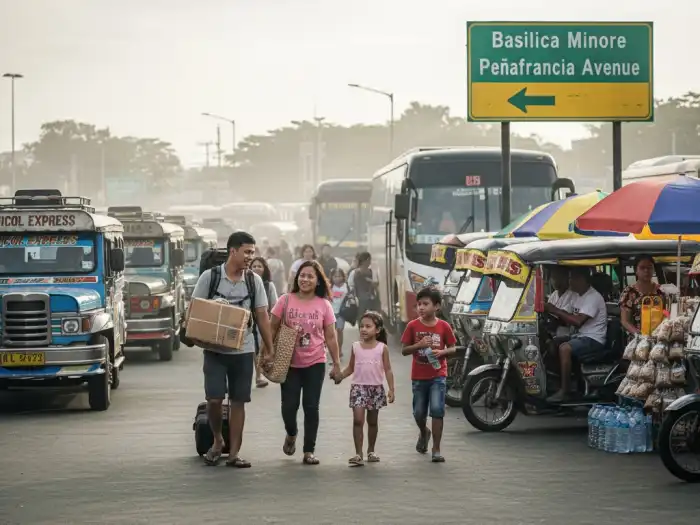
🧭 How to Get There & Travel Tips
Reaching Naga City for the Peñafrancia Festival feels less like a trip and more like a pilgrimage. Whether you’re coming for faith, photography, or the sheer magic of witnessing Ina’s fluvial return, planning ahead makes the experience smoother and more meaningful.
🚍 How to Get to Naga City
| Route | Travel Time | Details & Tips |
|---|---|---|
| From Manila (By Bus) | 8–10 hours | Take a DLTB, Isarog, or Peñafrancia Tours bus from Cubao or Pasay. Night trips are comfortable with aircon and reclining seats. Best to book 2–3 weeks ahead during festival week. |
| From Manila (By Plane) | 1 hour | Cebu Pacific flies daily to Naga Airport (Pili). From there, take a tricycle (₱100–₱150) or van (₱50–₱70) to Naga City proper. |
| From Legazpi or Albay | 2 hours | Vans and PUVs travel regularly via Maharlika Highway. Ideal for side trips around Bicol before or after the festival. |
| From Visayas / Mindanao | Varies | Take a flight to Legazpi or Manila, then transfer to Naga via bus or connecting flight. |
Traveler’s Move – Arrive by Thursday (Sept 10, 2026)
This gives you time to rest, explore the city, and attend the Traslacion without rushing. Hotels fill fast – booking early means better rates and locations near the basilica or cathedral.
🏨 Where to Stay During Peñafrancia Week
| Area | Why Stay Here | Budget Range (per night) |
|---|---|---|
| Centro / Naga Cathedral Area | Close to novenas and processions | ₱3,000–₱6,000 |
| Magsaysay Avenue | Access to restaurants, malls, and evening food stalls | ₱2,000–₱4,500 |
| Pili / Airport Vicinity | Quieter, with quick access to nearby towns | ₱1,500–₱3,000 |
| Peñafrancia Basilica Area | Best for devotees; walking distance to major religious events | ₱2,000–₱4,000 |
Local Hack – Choose a Hotel with a Balcony or Rooftop View
Some hotels along Magsaysay Avenue and Peñafrancia Avenue offer a front-row view of the processions. You’ll hear the hymns and see the candles without fighting the crowd.
🚶 Getting Around the City
Tricycles and jeepneys are your best friends. During the festival, roads near the Basilica, Cathedral, and Naga River are closed to vehicles – so prepare to walk.
Traveler’s Tip – Walk with the Pilgrims
The best experiences happen between destinations – when strangers offer water, street choirs sing hymns, and locals share homemade food with you. Walking connects you to the spirit of the celebration.
🎒 What to Pack
✅ Light and breathable clothes (Naga weather can be humid)
✅ Comfortable walking shoes or sandals
✅ Hat or umbrella for sun and rain
✅ Reusable water bottle
✅ Candle and handkerchief for processions
✅ Power bank and small sling bag
✅ Cash (some ATMs run out by weekend)
Pilgrim’s Tip – Carry a Small Candle and Join the Processions
Even as a visitor, lighting a candle or joining a short walk lets you share in the devotion. It’s not about religion – it’s about unity, gratitude, and peace.
🍲 What to Eat in Naga City
Naga is home to authentic Bicolano cuisine – rich, spicy, and soulful.
Must-tries:
-
Kinalas – a noodle soup with tender beef strips and gravy, best at Kinalas Twin or Aling Cely’s.
-
Bicol Express – coconut milk, pork, and chili perfection.
-
Laing – taro leaves cooked in creamy gata, best enjoyed with rice.
-
Pili Nuts & Toasted Siopao – your go-to pasalubong from Casa Moderna or Centro Naga Market.
Budget Move – Eat Like a Local at “Kinalasan Rows”
Near Plaza Quezon, small eateries serve hearty meals for ₱70–₱100. Locals line up early, proof that good food doesn’t need fancy plating.
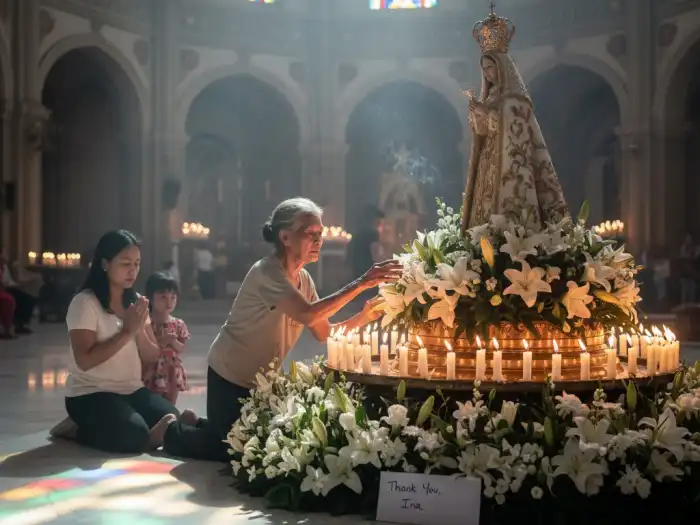
🕊️ Peñafrancia History & Cultural Significance
The story of Our Lady of Peñafrancia is one of faith passed down through generations – whispered in prayers, carried in processions, and etched into the soul of every Bicolano.
It all began in the early 1700s, when a young Spanish seminarian named Miguel Robles de Covarrubias, studying in Naga, fell gravely ill. He prayed to the image of the Virgin of Peñafrancia from Salamanca, Spain – the patroness of his hometown – and was miraculously healed. In gratitude, he built a small chapel by the river in her honor.
Word of Ina’s miracles spread quickly. From fishermen and farmers to soldiers and merchants, people began to visit her shrine to pray, give thanks, or seek healing. Over time, the devotion grew – and with it, the annual procession that would become the Peñafrancia Festival, now the largest Marian celebration in Asia.
🙏 The Symbol of “Ina”
In Bicol, Ina means more than “mother.” She’s protector, healer, and comforter – the one people turn to when hope feels far. The faithful believe that her intercession has brought countless blessings: healing from illness, safe journeys, restored families, and peaceful homes.
Her feast reminds Bicolanos of one simple truth: faith isn’t just believed – it’s lived. The way locals care for pilgrims, light candles, and open their homes to strangers are all quiet echoes of Ina’s love.
Faith Reflection – The River as a Symbol of Life
The fluvial procession isn’t just a spectacle – it’s deeply symbolic. The river represents life’s flow, and Ina’s journey upon it mirrors how grace moves through the people – sometimes calm, sometimes turbulent, but always finding its way home.
🕯️ The Traslacion and Fluvial – Dual Pillars of Devotion
The Traslacion, where Ina’s image is carried from her Basilica to the Cathedral, symbolizes the people’s journey to God – a walk of humility and surrender. Meanwhile, the Fluvial Procession, where she returns home by river, signifies grace returning to the faithful.
Together, these two rituals form the festival’s spiritual rhythm – a journey out and a journey back, mirroring how faith moves through joy, struggle, and renewal.
🌸 Peñafrancia and Bicolano Identity
To be Bicolano is to be a child of Ina. Her feast is woven into the region’s identity – from songs sung by children to murals painted in barangay chapels. The festival keeps Bicol’s heart beating with unity, hospitality, and devotion that transcend religion.
Even for non-Catholics, the Peñafrancia season is a time of reflection and community – a reminder that faith can unite, not divide.
Cultural Gem – “Viva la Virgen!” as a Shared Prayer
When the crowd shouts “Viva la Virgen!” it’s more than a cheer – it’s gratitude shouted to the heavens. You’ll hear it from every corner: whispered by mothers, shouted by teenagers, and sung by choirs along the river.
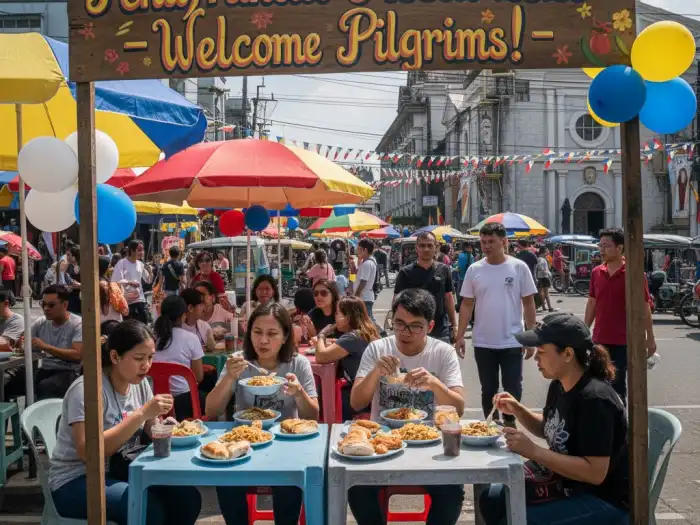
💡 Travel Hacks & Local Tips for First-Timers
The Peñafrancia Festival can be overwhelming the first time – hundreds of thousands of people, processions lasting hours, and emotions running deep. But with a few practical hacks and local wisdom, you’ll not only enjoy it – you’ll feel it.
🕘 Timing is Everything
If you want the full experience, plan your stay from September 10–22, 2026. This lets you witness both the Traslacion (opening) and Fluvial Procession (closing).
The Traslacion is held on September 11 (Friday) – expect crowds to build early. Locals line the streets as early as 4 AM, so secure your spot along Peñafrancia Avenue or near Naga Cathedral.
Timing Trick – Stay Until Monday (Sept 22)
Many tourists leave after the fluvial, but the Pagsungko ni Ina (Thanksgiving Mass) the next morning is quieter and deeply moving – a beautiful closing moment most visitors miss.
🚶 Where to Stand During the Processions
| Event | Best Viewing Spots | Why It’s Great |
|---|---|---|
| Traslacion Procession | Peñafrancia Avenue & Naga Cathedral vicinity | You’ll see the andas pulled by devotees and feel the raw energy of the crowd. |
| Fluvial Procession | Colgante Bridge & Peñafrancia Riverbank | Prime viewing for the river pagoda as it sails back to the basilica amid candle-lit boats. |
| Voyadores Festival | Magsaysay Avenue | Wide roads, food stalls, and street dance performances. |
Local Hack – Bring a Folding Fan or Hat
Naga’s September sun can be unforgiving, and processions can last hours. Locals bring banana leaves, towels, or portable fans – small comforts that go a long way.
💰 Budgeting for Your Pilgrimage
You can experience Peñafrancia on any budget. Here’s a practical 3D2N estimate:
| Expense | Estimated Cost (₱) |
|---|---|
| Bus or Flight (RT from Manila) | ₱2,500–₱5,000 |
| Accommodation (2 nights) | ₱2,000–₱4,000 |
| Food & Water | ₱800–₱1,200 |
| Souvenirs & Donations | ₱500–₱1,000 |
| Local Transport | ₱300–₱500 |
| Total Estimate | ₱6,000–₱10,000 |
Budget Move – Stay with Locals or Pension Houses
If hotels are full, try smaller inns, homestays, or pension houses near the basilica. Some Bicolano families even open their homes to pilgrims for free or donation-based stays – a true expression of Ina’s hospitality.
🕯️ Stay Safe in the Crowd
-
Keep valuables minimal – use a small sling bag or waist pouch.
-
Stay hydrated – bottled water refills are often free at church kiosks.
-
Always follow crowd marshals and police during the Traslacion and Fluvial – movement can get tight.
-
If traveling with kids or seniors, stick to side streets or elevated spots instead of main routes.
Devotee’s Reminder – Respect the Processions
Avoid pushing through crowds or taking selfies too close to the andas (carriage). Locals see the image as sacred – a quiet bow or sign of the cross is always appreciated.
🍴 Eat & Rest Like a Local
After the novena or procession, try Naga’s comfort eats:
-
Kinalas – noodle soup with beef and gravy, best after a long walk.
-
Laing & Pinangat – taro leaves cooked in coconut milk and chili.
-
Toasted Siopao – a Naga classic – sweet, flaky, and best with coffee.
Foodie Tip – Dine Late Evening
Locals usually eat after major events, so restaurants reopen around 9–10 PM. Try Geewan, Bob Marlin, or Que Pasa Naga for a solid post-procession meal.
🧳 Final Packing Reminders
✅ Candle and lighter (for prayers)
✅ Light clothes, extra shirt
✅ Foldable fan and hand towel
✅ Power bank and mobile data
✅ Hat or umbrella
✅ Plastic cover for bags (in case of rain)
✅ Simple offering (flowers or candles for Ina)
Traveler’s Heart – Come as a Devotee, Leave as Family
Even if you arrive as a tourist, you’ll leave with a deeper connection. Locals often say, “Pag naka-attend ka na kay Ina, babalik at babalik ka pa rin.” (Once you’ve joined Ina’s feast, you’ll always come back.)
❓ FAQs About Peñafrancia Festival 2026
1. When is the Peñafrancia Festival 2026 celebrated?
The Peñafrancia Festival 2026 will be held from September 11 to 22, 2026 in Naga City, Camarines Sur. The grand Fluvial Procession happens on September 21 (Sunday) – a must-see moment of devotion and spectacle.
2. What is the Peñafrancia Festival about?
It’s a religious and cultural celebration in honor of Our Lady of Peñafrancia, lovingly called Ina. The festival celebrates faith, unity, and miracles, making it one of the largest Marian events in Asia.
3. What are the main highlights of the Peñafrancia Festival?
Key highlights include the Traslacion Procession, Nine-Day Novena, Voyadores Street Dance, and the breathtaking Fluvial Procession along the Naga River. Each event represents a part of Bicolano devotion and artistry.
4. What does “Ina” mean in the festival?
“Ina” means “mother” in Bicolano. Devotees see Our Lady of Peñafrancia as their spiritual mother – a symbol of comfort, healing, and unwavering love for her children.
5. Where are the main processions held?
Major events happen between the Peñafrancia Basilica Minore and the Naga Metropolitan Cathedral, with the fluvial route flowing along the Naga River. Streets nearby are closed, turning the city into one massive pilgrimage site.
6. How can I join the processions?
Anyone is welcome to join, but follow marshals and keep a respectful distance from the andas (carriage) and pagoda. Wear comfortable clothes and bring candles – walking even a short distance is considered a heartfelt offering.
7. What should I wear during the festival?
Dress modestly and comfortably – light shirts, pants, or jeans are ideal. Avoid flashy or revealing clothing, as most events are religious. Always bring a fan, hat, and water.
8. How do I get to Naga City for Peñafrancia?
From Manila, you can take a DLTB, Isarog, or Peñafrancia Tours bus (8–10 hours) or fly directly via Cebu Pacific to Naga Airport (Pili). From there, tricycles and vans can take you to the city center in under 30 minutes.
9. What food should I try while in Naga?
Try Kinalas, Laing, Pinangat, and the iconic Toasted Siopao. Don’t forget Pili nuts for pasalubong – a proud Bicolano specialty loved by locals and visitors alike.
10. Why is the Peñafrancia Festival special to Bicolanos?
For Bicolanos, the festival isn’t just a tradition – it’s a homecoming of faith. It’s a time when families reunite, prayers rise with candlelight, and Ina’s love feels almost tangible in every tear, song, and smile.
🌅 Walk With Ina, Feel the Faith of Naga
The Peñafrancia Festival 2026 is more than a celebration – it’s a soul-deep experience. It’s waking up to church bells at dawn, walking barefoot among strangers who somehow feel like family, and watching the river glow under the light of a thousand candles.
Every “Viva la Virgen!” shouted into the sky carries stories – of prayers answered, of families reunited, of people coming home after years away. And even if you come to Naga as a visitor, you’ll leave with Ina in your heart.
So when September comes, make that trip. Join the crowd. Whisper your own prayer into the wind. Because in Naga, faith doesn’t stay still – it moves with the river, flows with the people, and finds its way home. 🙏💛
🧭 References
-
City of Naga Official Website – Peñafrancia Festival 2025
-
Tourism Promotions Board of the Philippines – Peñafrancia Fiesta Festival
-
Archdiocese of Caceres – Peñafrancia History
-
Philippine News Agency – 3 K cops to secure Peñafrancia Festival in Naga City
-
DataLine Ibalon – The 2025 Peñafrancia Festival in Naga City: A Pictorial



